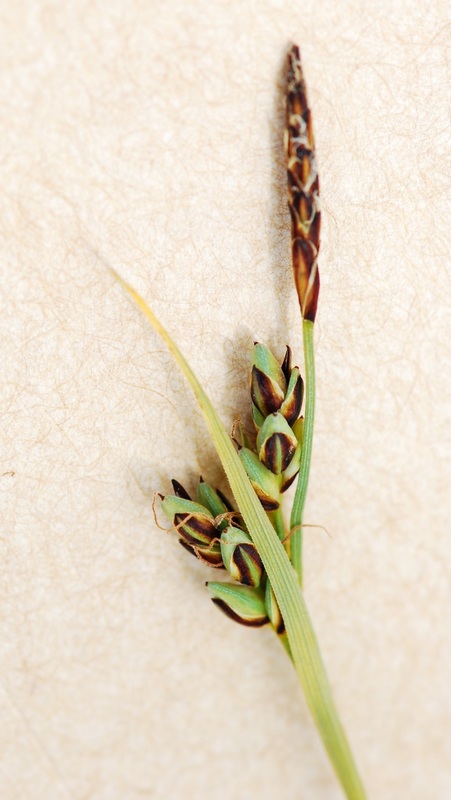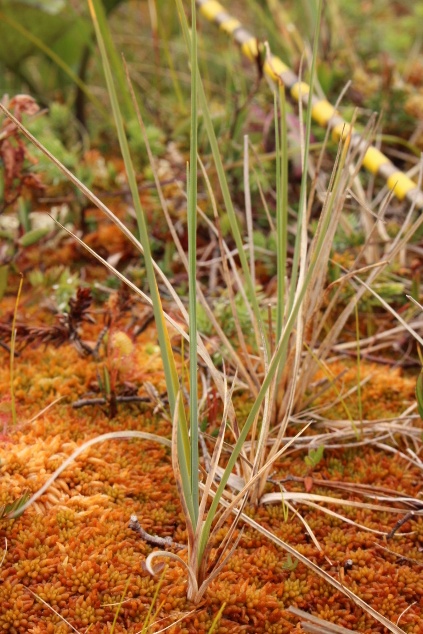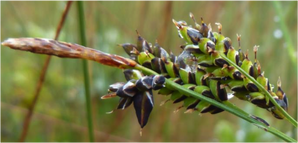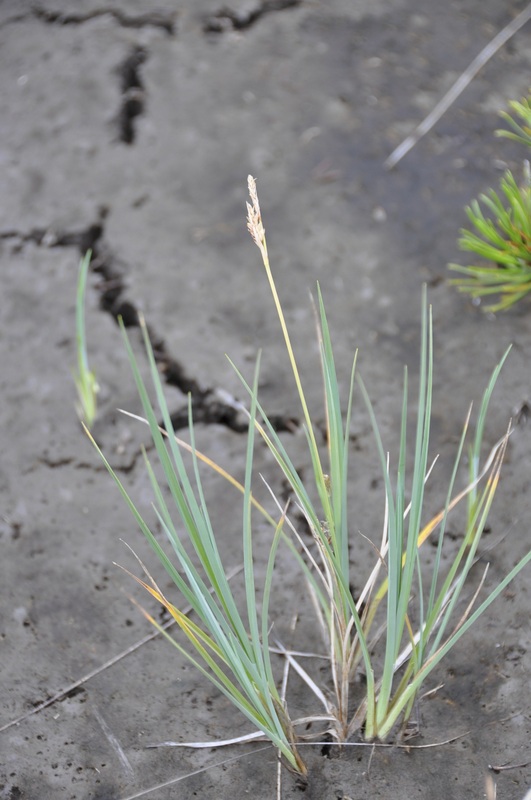Pale sedge, livid sedge • Carex livida
{livida = bluish-grey, leaf-coloured, leaden}
|
Top left and right: narrower male spike at the tip of the stem (terminal spike), with wider female lateral spikes. Photos by Nancy Shackelford (bottom left), Kira Hoffman (bottom right), Laura Kroesen (top right), and Kelly Fretwell.
|
Identification
Pale sedge is a perennial species that occurs singly or in loose tufts. Its smooth stems grow to 50 cm tall from long, thin rhizomes. The leaves are folded (forming a V-shape in cross-section), 1-3.5 mm wide, and are a bluish-green to bluish-grey colour. They attach to the lower third of the stems, and tend to exceed the stems in length. The inflorescence consists of a terminal male spike with 1-3 female lateral spikes, which tend to be upright or angled upwards. The lowest bract is leafy, long, and with an extended sheath. The flowers are green.
Habitat & Range
Pale sedge is found in moist to wet, shade-free habitats such as bogs, fens, swamps, stream-banks, and damp forests. It is a common coastal species at low to middle elevations, and is infrequently found in more eastern areas of BC. It is a circumpolar species, and is found across much of northern North America, northern Europe, Iceland, and eastern Asia.
Similar Species
Two similar species are woodrush sedge (C. ablata) and Henderson's sedge (C. hendersonii), but they are not found north of southern Vancouver Island and the nearby mainland .
Pale sedge is a perennial species that occurs singly or in loose tufts. Its smooth stems grow to 50 cm tall from long, thin rhizomes. The leaves are folded (forming a V-shape in cross-section), 1-3.5 mm wide, and are a bluish-green to bluish-grey colour. They attach to the lower third of the stems, and tend to exceed the stems in length. The inflorescence consists of a terminal male spike with 1-3 female lateral spikes, which tend to be upright or angled upwards. The lowest bract is leafy, long, and with an extended sheath. The flowers are green.
Habitat & Range
Pale sedge is found in moist to wet, shade-free habitats such as bogs, fens, swamps, stream-banks, and damp forests. It is a common coastal species at low to middle elevations, and is infrequently found in more eastern areas of BC. It is a circumpolar species, and is found across much of northern North America, northern Europe, Iceland, and eastern Asia.
Similar Species
Two similar species are woodrush sedge (C. ablata) and Henderson's sedge (C. hendersonii), but they are not found north of southern Vancouver Island and the nearby mainland .
References
Carex livida (Wahlenb.) Willd. In Klinkenberg, Brian. (Ed.). E-Flora BC: ElectronicAtlas of the Plants of British Columbia. Lab for Advanced Spatial Analysis, Department of Geography, University of British Columbia, Vancouver. Accessed 11/09/2013.
Pojar, J. and MacKinnon, A. (1994). Plants of Coastal British Columbia. Vancouver, BC: Lone Pine Publishing. P. 401.
Authors and editors of page
Kelly Fretwell and Brian Starzomski (2013).
Carex livida (Wahlenb.) Willd. In Klinkenberg, Brian. (Ed.). E-Flora BC: ElectronicAtlas of the Plants of British Columbia. Lab for Advanced Spatial Analysis, Department of Geography, University of British Columbia, Vancouver. Accessed 11/09/2013.
Pojar, J. and MacKinnon, A. (1994). Plants of Coastal British Columbia. Vancouver, BC: Lone Pine Publishing. P. 401.
Authors and editors of page
Kelly Fretwell and Brian Starzomski (2013).








